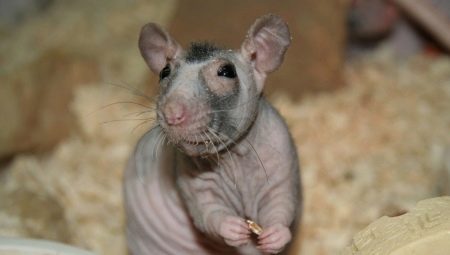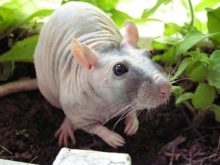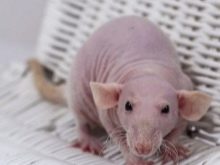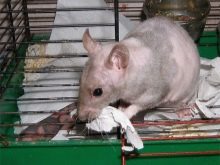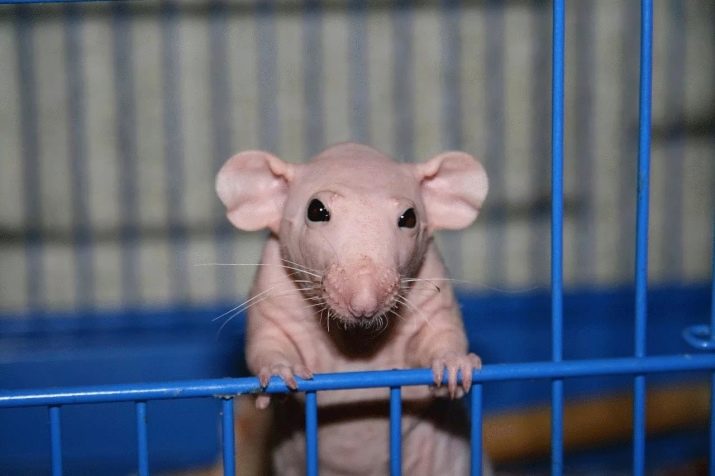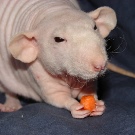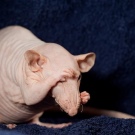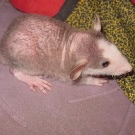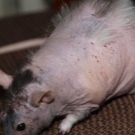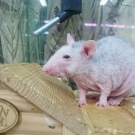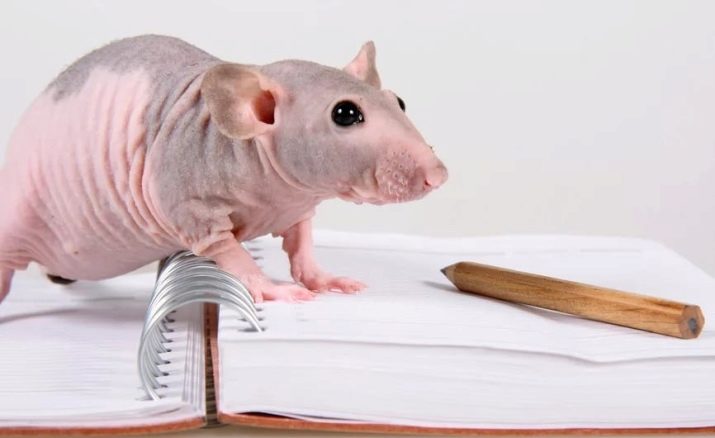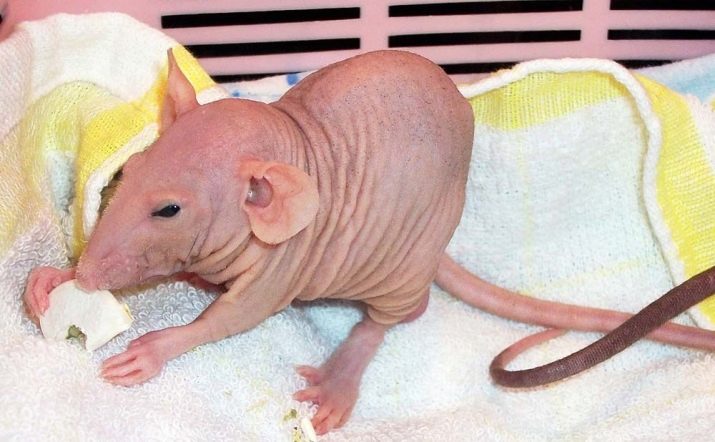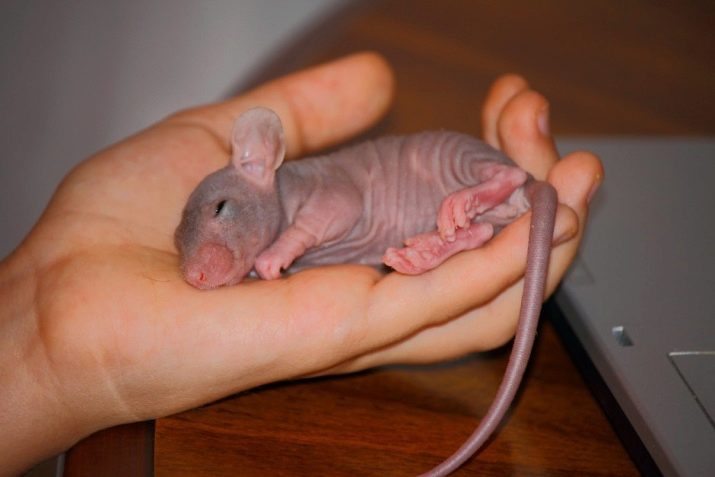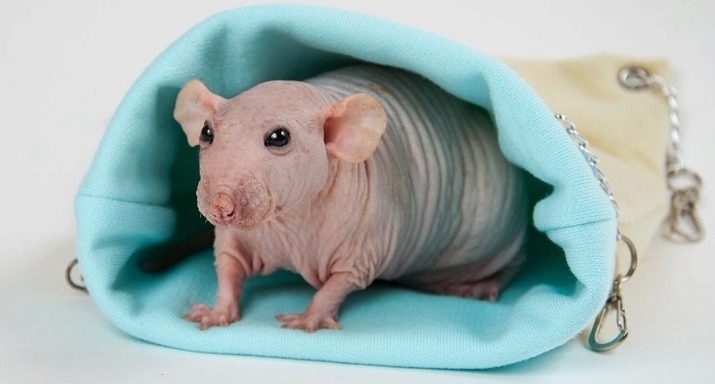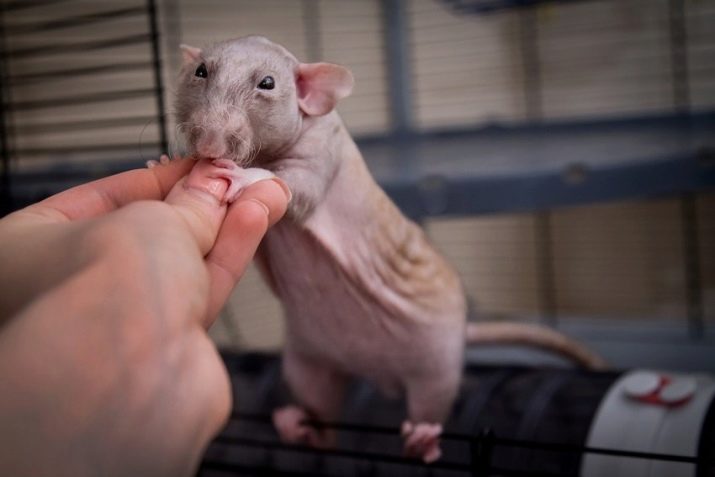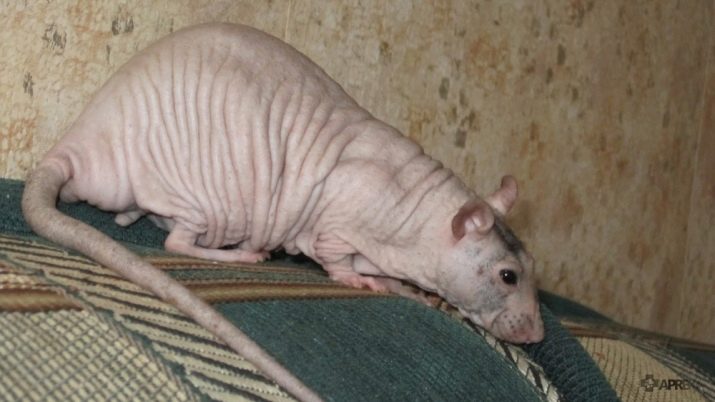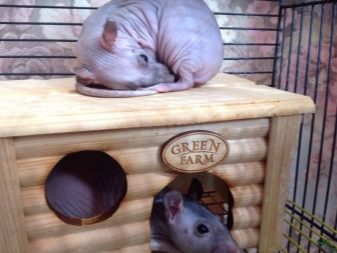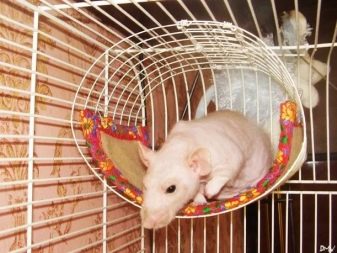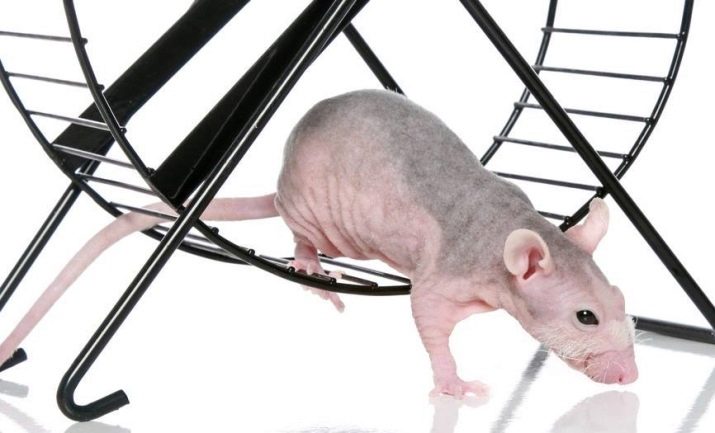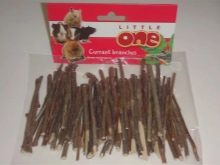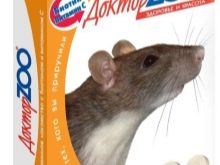Exotic pets recently enjoyed great popularity. This trend has not bypassed rodents, which are very often bred as decorative pets. Today, the bald rat is actively cultivated by many breeders; therefore, sphinx fans can be found all over the world.
Description
The breed of hairless rodents or simply sphinx was artificially obtained by an American scientist. Initially, these animals were needed for various experiments and studies, but over time, strange bald rats interested people as decorative pets. This was the impetus for individuals to go beyond scientific laboratories and laboratories.
There are three pedigree species of sphinxes.
- Standard. Rodents with long whiskers and small areas with fur on the skull, limbs and sides. Some breeders because of their external features are called individuals porcupines.
- Rex. Rats with twisted vibrissae and a rather rare wavy hair coat on the head, in the groin area, on the legs.
- Double Rex. In individuals of this species on the body there is a rare coat.
Since the hairless gene is recessive, it is not transmitted to every animal. This led to the birth of rodents with partial hair covering on the body. Such distinctive features in appearance suggest the classification of animals into several subspecies. Today we can highlight the following:
- hairless;
- naked;
- fluffy;
- balding;
- naked;
- sheared.
Immediately after birth, one can observe how the fur grows and covers their bodies in rodents, but then falls out, resulting in sparse hairs on rats. Therefore, based on the hairline, an animal can be attributed to one or another subspecies not earlier than six weeks after its birth.
The size of sphinxes can vary within 15–25 centimeters, while the mass of adults is 400–700 grams. In light of the lack of undercoat and wool itself, animals have a rather elegant body shape.
As for the skin color of bald ornamental rats, ideally, it should be pink in color, free from defects and blotches. In this case, the presence of folds is allowed, to the touch the body of the animal will resemble velvet. As a rule, boys are distinguished by more dense skin than girls. Now, by breeding animals were bred, the skin color of which would not be pink, but smoky, black, cream and even chocolate.
Rodents have whiskers (vibrissae), which are located near the eyes. Antennae twist slightly, in the light of which they will be visually less in length than in ordinary ornamental rats.
Some individuals may not have vibrissae, however, this feature will indicate a deviation from the established standards of appearance inherent in sphinxes.
It may be noted in bald individuals some difference in the shape and fit of the ears. As a rule, they will be planted fairly low, in addition, their sizes will be larger in comparison with the ears of ordinary rodents. There are animals with a characteristic form of auricles, like in dumbo rats. Sphinx eyes are pronounced, located on both sides of the skull. The color of the pupils can be black, husky, red and even pink. Among the animals of this breed it is also possible to meet animals with different eye color.
Sphynxes are distinguished by their appeasable disposition, however, this does not affect their activity in any way, therefore rodents are willing to play and also very quickly get used to their owners. This feature is due to the character of bald rats by the fact that due to their lack of hair, animals can and should be given more time to spend on direct contact with a person — on their hands, in their bosoms, on the shoulder. The outgoing heat from the body of the owner acts on them peacefully, besides, it warms.
At home, with regular contact with a person, rats are able to very sensitively recognize the mood of the owner by the intonation of his voice. Therefore, the breeder should control their timbre when communicating with the pet, so as not to frighten him. Bald rats are able to memorize and respond to their nickname. The animals are clean, therefore, when free-range on housing, breeders do not have problems with cleaning the products of sphinx vital functions in their places of movement.
The life span of a bald ornamental rodent is 1.5–2 years; however, if it is proper to care for the rodent and provide him with a balanced diet, he will be able to live with the person longer.
Advantages and disadvantages
The decorative breed of bald rats stands out for its strengths and weaknesses. The advantages of animals should include such moments:
- due to the lack of wool of such pets, it is possible to start even in the presence of a person's allergic reactions to animal fur;
- rats almost do not exude an unpleasant smell characteristic of small rodents;
- unlike hamsters, sphinxes are very contacts, so they are quite willing to go into the hands of a person;
- animals stand out for their decorative appeal due to the unusual appearance;
- Bald rats have high intellectual abilities, so they recognize the mood of a person well, and are also able to memorize their nickname.
Among the minuses of such rodents are the following nuances:
- sphinxes can suffer from depression alone, so be sure to communicate with animals;
- rodents are not long-lived, therefore one individual with a human will not live long.
Care and maintenance
For such exotic pets the main point concerning the content is the temperature in the room. Experts recommend placing cells with rodents in rooms where the air will be heated in the range from +22 to +30 C. Sometimes you can allow an increase in the thermometer to +35 C.
In winter, sphinxes usually contain near heating devices or radiators. As for the summer months, bald rats should be protected from the sun's rays, because due to the lack of wool, they may be burned by ultraviolet radiation.
The optimal indicator of air humidity will be 75–80%, an increased rate of humidity can cause the development of various rodent ills.
Dwelling
Pets live in spacious cages with metal rods, inside them should be placed a container for food, a drinker, as well as cuts of paper or napkins as a material for creating a nest in which the sphinx will sleep. A suitable house size will be 70x70 centimeters, in such conditions the rodent will have enough space for movement. It is best to choose houses with several tiers, with ladders and partitions.
In addition to the material for the nest, it is necessary to install a small house inside the cage, in which the rodent will rest and sleep, and also hide if necessary. Animals rather readily sleep in hammocks.
Cleaning in the house is recommended twice a week., also the rodent will need a tray. As a filler, you can use regular products designed for cat litter.
For games and physical activity, rats do not need a wheel, the walking ball will be the best option for such a pastime.
Nutrition
With regard to the diet of a bald rodent, such pets can be fed with specialized fodder mixtures, additionally treating with vegetables and fruits. Sphynx should be given boiled fish and meat once every seven days, vegetables should also be boiled beforehand. Animals can not be salted, smoked and spicy food, you should abandon the temptation to treat the rodent with sweets from the common table.
The most favorite delicacy for an ornamental rat will be cheese, however, you can pamper an animal no more than once a week.
Hygiene
In sphinxes, claws on the fore and hind limbs grow rather quickly, so the owner will need to be in the process of caring for a rodent cut them once a month with sharp scissors. Neglect of such rules will further be fraught with wounds on the body of the animal, in addition, the rat can injure its owner with its claws in the process of communication.
Pet is recommended once every 2-3 months to bathe in warm waterHowever, additional care products cannot be used, water for hygienic procedures will be quite sufficient, since the rat in the intervals washes and takes care of itself independently.
For such small rodents a very important point is the attention from the breeder - if the owner knows in advance that for the most part the rat will be at home alone, he should acquire several sphinxes at once. It is best to choose animals of the same sex and from the same litter. But this does not negate the need for daily contact and communication with the rat.
As noted earlier, bald rats are not distinguished by their vitality, most often the rodent suffers from a variety of skin ailments. Some abrasions and wounds on the body of an animal can turn into purulent ulcers.
Another common disease among sphinxes is oncology, this predisposition is due to gene mutations, as well as the absence of hair. Similar diseases in rats can not be treated.
Rats breed well at home, in females in heat comes every 5-7 days. That is why heterosexual animals living in the same cage will regularly bring breeders to the breeder. Sick animals are not recommended to mate, because there is a chance that they will give their illness to offspring.
It is forbidden to take newborn rats into their arms, since sphinxes, like most rodents, can detect all cubs if they detect extraneous smells from offspring. It is possible to drop bald rats into a separate house in a month after birth.
Professional Tips
Sphynx breeders strongly recommend buying such decorative pets exclusively in specialized pet stores, since animals that are offered in natural markets are often kept in violation of conditions, which is fraught with further problems with the health of individuals. In addition, experts can get important recommendations on the care of a decorative rodent.
Sphynx breeders recommend to pay attention to the fact that the animals regularly updated teeth. To contribute to the rats in a smooth and proper course of these processes, in the house should be placed a piece of wood.
Rats need mineral supplements, for this purpose it is recommended for pets to buy vitamins or to put chalk in a cage.
For inexperienced breeders who have purchased two pets of different sexes, however, they do not plan to breed animals, many veterinary clinics offer services for the sterilization and castration of animals. This will avoid possible problems with the numerous offspring of bald rats in their home.
In the next video, see the opinion of a little breeder about his pet - a bald rat.
